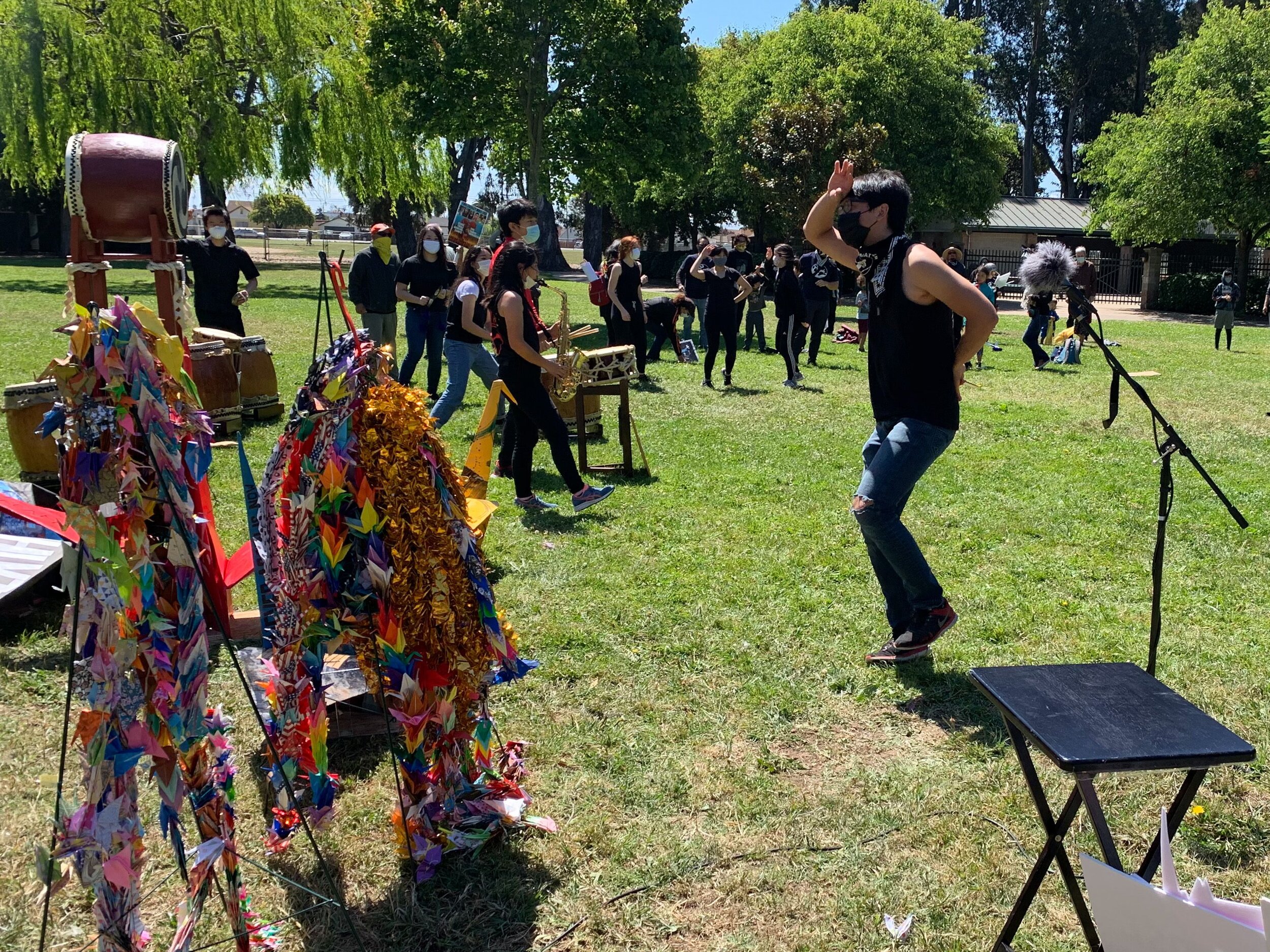Tsuru for Solidarity
Ei Ja Nai Ka at Tsuru for Solidarity, Tsuru Rising Demonstration, San Francisco, June 2020 (photo: Josh Kaizuka)
BY GREGORY WADA
On June 7, 2020, a coalition of Japanese American organizations met at a park in South San Francisco on the boundaries of the former Tanforan detention center, where nearly 8,000 Japanese Americans from the Bay Area were detained before to being sent to Topaz, one of the ten permanent “internment camps” operated by the US government during WWII.
The Tsuru for Solidarity movement grew with the recognition and need to stop the same injustices from reoccurring today, as we once again see children separated from their families, held in cages, pulled from their schools. “When we were sent away,” I’ve often heard the elders say, “no one stood up for us. Today, we must stand up and not let that happen again.”
The Tsuru Rising weekend of action was put together through the collaborative effort of grassroots organizations, including Japanese Americans for Justice, Nikkei Resisters, the Florin Japanese American Citizens League, and Bakuhatsu Taiko Dan.
Ei Ja Nai Ka at Tsuru for Solidarity, Tsuru Rising Demonstration, San Francisco, June 2020 (photo: Josh Kaizuka)
WHAT DOES IT MEAN TO BE A TAIKO PLAYER?
I think this is a time for taiko players to use their art to examine and enact social change. North American Taiko has such a rich history in activism and community building, and I think these times really challenge us again with the question, “What does it mean to be a taiko player?” Within my teaching capacity with Bakuhatsu Taiko Dan, I try to encourage students to explore those questions as they learn the instruments.
“I would like the voice of taiko to be that for the communities fighting oppression today. ‘We hear you, keep going!’”
This year, our team performed in demonstration against immigrant detainment at Yuba County Jail as well as the Tanforan demonstration. These performances have brought something raw and powerful to the intentionality behind the art of taiko, as well as to the relationships and energy between performer and audience. I think this involvement can both transform us as performers and leave an impression on audiences that might last a lifetime. At Yuba County Jail, the detained yelled out to us from the inside that they could hear us and to keep playing. I would like the voice of taiko to be that for the communities fighting oppression today—“We hear you; keep going!”
Ei Ja Nai Ka at Tsuru for Solidarity, Tsuru Rising Demonstration, San Francisco, June 2020 (photo: Josh Kaizuka)
As for the piece used in the demonstration, I was particularly drawn to Ei Ja Nai Ka, a Bon Odori piece written by PJ Hirabayashi, with movements and lyrics that reflect on unifying themes of the immigrant experience and our own roots as Japanese Americans. From crossing rough waves with a dream to hard work in fields and industry and passing on traditions and memories to the next generation, it is a piece that is self-aware of the connection between taiko and the lives of those communities who play the drums. Bon Odori is a beautiful tradition that enacts our embodied memory and experiences as Japanese Americans.
A DANCE FOR CHANGE
Ei Ja Nai Ka is a dance that encourages participation and the absolution of the ego, while explicitly and lovingly remembering those who have passed on. From this grounded place, I think we can widen our lens and see the connectivity between all peoples as we seek our collective liberation. The mythical story of Obon concerns the journey of one man to free his mother from suffering in the afterlife, but through this enactment, do we not dance to free us all?
“Ei Ja Nai Ka is dance that encourages participation and the absolution of the ego, while explicitly and lovingly remembering those who have passed on. From this grounded place, I think we can widen our lens and see the connectivity between all peoples as we seek our collective liberation.”
Facing the many injustices of the world, the speeches at the demonstration were filled with righteous anger and deep sorrow, as is the long arc of our past. But to come together at the end, old and young, to recall our ancestors and joyously dance in their memory also carries the hope of tomorrow. That we continue to dance at Obon to this day is an act of resistance, smiling through the heartache. Our feet don’t stop moving; the drums connect yesterday and tomorrow.
ABOUT THE AUTHOR
Gregory Wada is an anthropologist, activist, and taiko player from UC Davis. He is the founder and director of the Davis Cherry Blossom Festival, an annual event dedicated to the role of music and art in enacting social justice, and president of the Center for Archaeological Research at Davis. He teaches taiko and performs with Bakuhatsu Taiko Dan and the Hanabi Ensemble.




